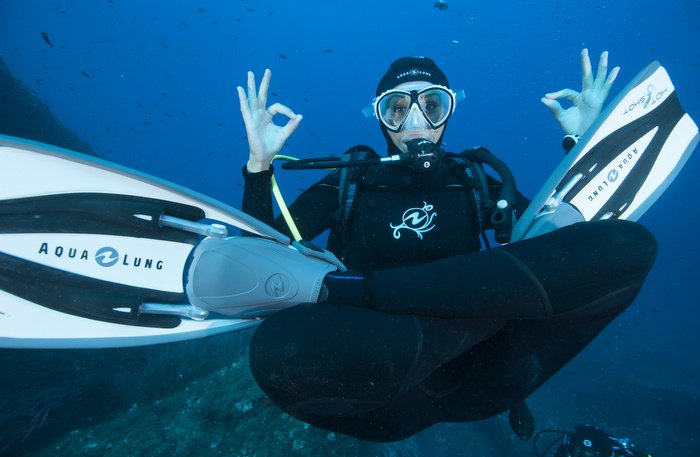Diving: Avoiding missed experiences

PHUKET: There is no substitute for the first time a diver sees – assuming they’re not having mask issues – the majestic wings of a giant manta ray as it sweeps in from the deep blue. A shadow at first that grows larger and larger until you realize that the manta has come to see what this funny bubble blower is all about…
Shortly after jumping from Blue World Safari during a day-trip to Hin Muang, there was that magical moment. Many in the group had never seen a giant manta ray before, my dive buddy included. As it stretched its wings and glided across one of the pinnacles, painted purple with soft corals, I looked for my buddy. She was about five or six meters away, looking down into the deep blue below as she fiddled with her mask.
It wasn’t clear if her mask was fogging up, if it was leaking or if her hair had just gotten stuck in the strap. Either way the seconds slipped by slowly, painfully. Eventually, she looked up and was greeted by one of the greatest treasures of the marine world. However, not everyone is so lucky – many more experiences below the ocean’s surface come and go in seconds.
When it comes to bad mask experiences, most divers have had them: the mask that leaks the entire time, the mask that instantly fogs, the mask that does both and even the mask that hurts.
For those of us with weird faces, the issue is even more persistent, and despite diving for years with poorly fitting masks that have either sent me swimming with my eyes closed half the time because I was tired of clearing the mask, to just turning every precious nudibranch into a colorful blur, it had never occurred to me how essential a perfect mask was until I thought my buddy was going to miss her first manta.
Darren ‘Dmo’ Moss, direct sales manager and customer service for Aqua Master, knows masks.
I clearly didn’t. Like many divers I assumed if you sucked in through your nose and the mask stuck: Hey! It was a good fit.
“I deal with people sucking masks to their face everyday. Any mask will fit when you are using physics like that, but that doesn’t mean it will fit when you’re diving,” Dmo says, months after the manta dive. “It’s mimicking the mask being under pressure. However, when you dive you equalize, so it really is a false fit.”
Dmo is up-selling me though.
“The best mask isn’t the most expensive mask or cheapest mask. It’s the one that fits best, which is why Aqua Lung puts so much effort into creating new technology and a variety of skirt shapes when developing their masks.”
So the crux of a perfect mask hunt is: how do you know if it fits? The simple answer is that it takes time, as a diver needs to try on a variety of masks, pressing them to his or her face gently and letting a friend or store representative check the seal of the skirt around the lips, cheeks, nose, eyebrows and eye sockets.
“Common places for a mask to leak is along the eyebrows, eye sockets and just below the nose,” Dmo explains.
“We test clearing, equalizing and what I call the joop-joop test – where it’s simulating having a regulator or snorkel in your mouth by pouting your lips like a kiss – this is to make sure the seal doesn’t break.”
Finding a good mask is like finding a good shoe – you tend to try on a number of running shoes, even from the same brand – before settling on the best shoe for you. In that same train of thought, it’s hard not to feel like you’re walking into the shoe store when it comes to the variety of masks that even one company, such as Aqua Lung, has on show. Also, like in running shoes, there is real technology pushing the advancement of masks, the kind of technology that go beyond salesmanship and into significantly improving a diver’s experience.
In general, a diver needs to take into account the fit – which you should have guessed by now – lenses, strap technology, volume of the mask and perhaps the color of the skirt.
LENS
When it comes to single verses bi-lense masks, it really comes down to preference, though those who want prescription lenses – which can easily be set in four different models of Aqua Lung masks at the Aqua Master service center in Chalong – will have to go with the bi-lense. However, for the rest of us, it really comes to comfort.
STRAP
Some might scoff at ‘strap technology’, but for divers with long hair – from Rasta dreads to golden locks – there can be quite a tangle if you’re not careful with your strap. Or, the mask will end up getting pulled up as the strap is placed above a hair bun or pulled down if the strap is placed below the bun – neither is ideal.
To combat this – as part of a series of masks developed by women for women – Aqua Lung rolled out a Comfort Buckle System (CBS), that apparently does wonders.
VOLUME
Volume is simple: low-volume masks are better. They create less buoyancy, are quicker to clear and are easier to equalize. However, the real selling point is that low-volume masks bring the lens closer to your eyes, which increases your field of vision. The more you can see – clearly – the more opportunities you have to witness those underwater moments a person carries with them for a lifetime.
COLOR OF SKIRT
Despite what some people might say, the clear silicone used for the skirt of a Aqua Lung mask when it is created in Italy is the exact same quality as the black silicone.
The real difference is that as a beginner the extra light allowed in by a clear skirt can be more comforting and also enhance the experience of seeing all the bright wonderful corals at places like Hin Muang. On the other hand black silicone is going to provide some eye protection at the surface – it is often preferred by photographers and freedivers.
— Isaac Stone Simonelli
Latest Thailand News
Follow The Thaiger on Google News:


























